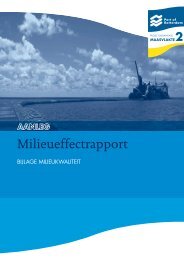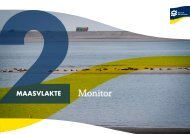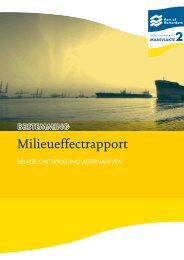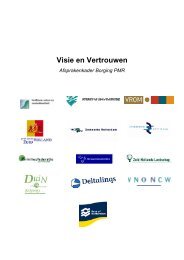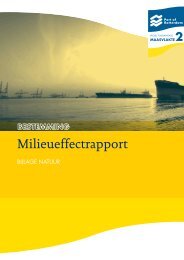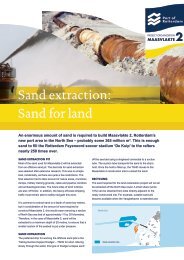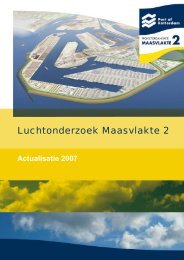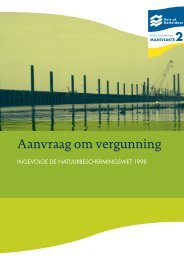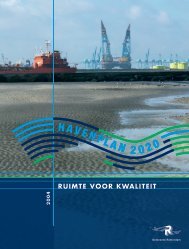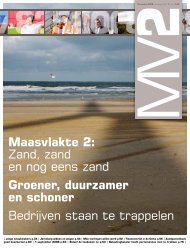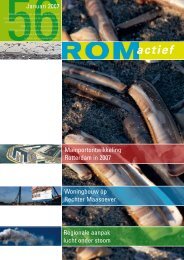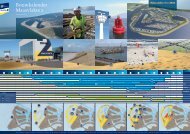Maasvlakte 2 The sustainable port (pdf, 6427Kb)
Maasvlakte 2 The sustainable port (pdf, 6427Kb)
Maasvlakte 2 The sustainable port (pdf, 6427Kb)
- No tags were found...
You also want an ePaper? Increase the reach of your titles
YUMPU automatically turns print PDFs into web optimized ePapers that Google loves.
SUSTAINABLE CONSTRUCTION33Boskalis and Van Oord will becollaborating on the constructionof <strong>Maasvlakte</strong> 2. <strong>The</strong>y have beencommissioned to perform this taskas innovatively and sustainably aspossible. <strong>The</strong> dredgers will beworking with modern, clean, andconstructed consisting of duneswith a beach. A total of more than365 million cubic metres of sandwill be required for the constructionof the sea wall and the 1,000 ha ofgrantable sites. Some 60 millioncubic metres of sand will beit was decided to extract sand at ashort distance from <strong>Maasvlakte</strong> 2,as this minimises the negativeenvironmental impact of theoperation. <strong>The</strong> sand will beextracted outside the Voordeltaarea.Eco-friendly sandextraction and landreclamationenergy-efficient vessels. Allcontractors all obliged to work inaccordance with the guidelinespertaining to the <strong>sustainable</strong>construction of structures, roads,and waterways.Construction of the sea wallAll in all, the sea defence thatsurrounds <strong>Maasvlakte</strong> 2 will bearound 12 km in length. At thenorthern end, a 4-km long sectionof the sea wall will have a hard toplayer of basalt, concrete, or rock.<strong>The</strong> existing <strong>Maasvlakte</strong>‘Blokkendam’ will be partiallyrecycled for this new hard sea wall.This means less waste and a lesserneed to ship in new material. Onthe western and southern edges,an 8-km long soft sea wall will beextracted when the Yangtzehavencut-through is carried out and thenew <strong>port</strong> areas are brought to thedesired depth. This sand will bereused in the <strong>Maasvlakte</strong> 2development. <strong>The</strong> remainder ofthe required sand will be extractedfrom the North Sea seabed.Sustainable sand extraction<strong>The</strong> location of the sand pit in theNorth Sea was determined inaccordance with the conditions ofthe Key Physical Planning Decision(PKB). This is guaranteed by theearth removal licence. It wasestablished on the basis ofextensive research to determinethe offshore locations where sandextraction would have the leastimpact on marine life. Furthermore,<strong>The</strong> effects of the sand extractionoperations on organisms in and onthe seabed and on fish and siltlayers are described in theEnvironmental Impact AssessmentConstruction. Two clear effectshave been determined: the seabedecosystem will be affected andthere will be silt formation.Deep sand extraction pits willlimit the disruption of the seabedecosystem<strong>The</strong> extraction of sand at theoffshore pit will also result in thedisappearance of local seabedorganisms. Thanks torecolonisation, the estuarineecosystem will recover within a fewyears. During the sand extractionactivities, the negativeenvironmental effects will be limitedas far as possible by using deepsand extraction pits to a depth ofsome ten to fifteen metres belowthe sea floor. By workingdownwards instead of sidewards,the total surface area of temporarilydisturbed seabed can be reduced.



